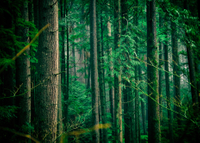Old-growth forests are Canada’s—and the world’s—lungs and they’re worth protecting for the sake of our future and the planet’s
Folks across B.C. and beyond have been standing in solidarity with old-growth forests, in hopes to protect some of the last mature trees on the planet. These areas are scarce and are often in the most danger of being stripped for development by the logging industry; they’re also a crucial player in helping to mitigate climate change and protect biodiversity.
Old-growth forests versus second-growth forest
Second-growth wooded areas are regrown after a timber harvest, and though they may look the part, they very much differ from our mature forests. Old-growth forests are untouched by human activity, and allowed to attain not only immense size but age. With this, they’re able to help mitigate environmental consequences in ways that a younger forest can’t always do.
- Old-growth forests have large, older trees with multilayered canopies. These gaps in the canopy allow the sunlight through and create more diverse and layered plant and animal life. Second-growth forests tend to have closed canopies that block out most sunlight, creating sparser biodiversity throughout the layers of the forest.
- Old-growth forests have trees of diverse ages and heights within the same area, including fallen dead trees that provide nutrients, structure and water retention for new growing trees. Over time, species have evolved to live in these canopy levels, which make them crucial for maintaining native biodiversity. Second-growth forests have single-layer canopies due to them being a similar age and therefore height. Their bark isn’t a host to the diverse array of lichens, mosses, ferns and fungi the way that old-growth forests are. Overall, old-growth forests help to support unique and diverse species because of the lack of outside stressors and through their good balance of available resources.
- Old-growth forests store carbon better than new trees. They are the most effective carbon sinks because they have a greater mass of leaves, which rely on carbon to grow. When the leaves fall and decompose, much of the carbon migrates down into the soil and serves as a useful nutrient rather than a contributor to global warming.
- Old-growth forests contain properties that benefit their region and people who live nearby. Younger forests don’t contain the proper root structures or fallen and decaying trees that help to protect our water systems, form healthy soil, and break down ambient air pollution.
 Photo by Jachan DeVol on UnsplashThe impact on humans and climate change
Photo by Jachan DeVol on UnsplashThe impact on humans and climate change
Old-growth forests are in need of protection for the sake of our biodiversity, but also to continue in the fight against global climate change. Not only do they provide oxygen and cool the earth by creating shade and releasing water, but the centuries of growth and increased biodiversity have made them more equipped to withstand wildfires and other climate-related impacts.
Old-growth forests tend to be more resilient due to their structural diversity, and will cope better than younger forests as climate change worsens. Their continued life and growth is critical for protecting people and wildlife from continued droughts, floods and wildfires caused by climate change.
Over time, old-growth forests have also sequestered massive amounts of carbon per hectare (and this rate actually increases continuously as they grow). When harvested, the trees release huge amounts of carbon back into the atmosphere. Protecting old-growth forests also reduces our emissions and ensures that carbon is kept safely stored away where it belongs: in the trees and soil.
How can we help protect old growth forests?
Here are a few ways that you can take action to protect trees that have been here longer than most of us have been alive.
- Ensure policymakers preserve old-growth forests by signing petitions:
- Sign the petition demanding a moratorium on logging B.C.’s remaining ancient trees.
- Petition to protect B.C.’s endangered old-growth forests and forestry jobs.
- Petition to protect B.C.’s old-growth rainforests.
- Stop logging in B.C.'s old-growth rainforests.
- Tell John Horgan’s government to keep their promises and #SaveOldGrowth
- Support Indigenous communities in regaining sovereignty over their ancestral lands. They’ve been fighting for old-growth forests for decades.
- Use the power of your voice. Use social media and other platforms to share the petitions, this article, and inspire other to save old-growth forests.

